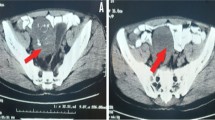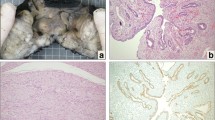Abstract
Persistent Müllerian duct syndrome is a rare condition occasionally encountered in men with normal phenotype but with presence of Müllerian duct structures. In India, owing to neglect and lack of facilities, we encounter this condition in adult males. We encountered on the same day in the operation theatre two phenotypic males aged 40 years and 10 months who had inguinal hernia on one side along with contralateral undescended testis. Both patients intraoperatively had uterus with fallopian tubes and underwent subtotal hysterectomy with preservation of vas. Repair of inguinal hernia with fixation of the testis in the scrotum was done. Though rare, every surgeon operating upon inguinal hernia or undescended testes or cryptorchidism needs to know about the presence of the uterus in a phenotypic male patient at any age. High degree of suspicion and awareness is needed to diagnose this condition. Early treatment is needed to maintain fertility and to prevent the occurrence of malignancy in remnant müllerian structures.





Similar content being viewed by others
Abbreviations
- PMDS:
-
Persistent Müllerian duct syndrome
- MIF:
-
Müllerian inhibitory factor
- MGD:
-
Mixed gonadal dysgenesis
- TTE:
-
Transverse testicular ectopia
References
Mandhan P, Hussain I, Rubab N, Ahmed J, Ali MA, Aziz A (1999) Persistent müllerian duct syndrome: report of two boys with associated transverse testicular ectopia. J Pak Med Assoc 49:74–76
Josso N, Belville C, di Clemente N, Picard JY (2005) AMH and AMH receptor defects in persistent mullerian duct syndrome. Hum Reprod Update 11(4):351–356
Hoshiya M, Christian BP, Cromie WJ et al (2003) Persistent müllerian duct syndrome caused by both a 27-bp deletion and a novel splice mutation in the MIS type II receptor gene. Birth Defects Res A Clin Mol Teratol 67(10):868–874
Loeff DS, Imbeaud S, Reyes HM, Meller JL, Rosenthal IM (1994) Surgical and genetic aspects of persistent mόllerian duct syndrome. J Pediatr Surg 29:61–65
Manjunath BG, Vasanth G, Shenoy PR (2010) Persistent müllerian duct syndrome: how to deal with the müllerian duct remnants—a review. Indian J Surg 72:16–19
Wu HC, Chen JH, Lu HF, Shen WC (2000) Persistent mullerian duct syndrome with seminoma: CT findings. AJR Am J Roentgenol 174:120–124
Gutte AA, Pendharkar PS, Sorte SZ (2008) Transverse testicular ectopia associated with persistent Müllerian duct syndrome—the role of imaging. Br J Radiol 81:176–178
Berkmen F (1997) Persistent müllerian duct syndrome with or without testicular ectopia and testicular tumours. Br J Urol 79:122–126
Gauderer MW, Grisoni ER, Stellato TA, Ponsky JL, Izant RJ Jr (1982) Transverse testicular ectopia. J Pediatr Surg 17:1–2
Martin L, Benette AH, Cromie WJ (1992) Persistent müllerian duct syndrome with transverse testicular ectopia and spermatogenesis. J Urol 147(6):1615–1617
Imbeaud S, Rey R, Berta P et al (1995) Testicular degeneration in three patients with the persistent müllerian duct syndrome. Eur J Pediatr 154(3):187–190
Vendersteen DR, Chaumeton AK, Ireland K, Tank ES (1997) Surgical management of persistent mullerian duct syndrome. Urology 49(6):941–945
Romero FR, Fucs M, Castro MG, Garcia CR, Fernandes Rde C, Perez MD (2005) Adenocarcinoma of persistent müllerian duct remnants, case report and differential diagnosis. Urology 66(1):194–195
Thiel DD, Erhard MJ (2005) Uterine adenosarcoma in a boy with persistent müllerian duct syndrome: first reported case. J Pediatr Surg 40(9):e29–e31
Shamim M (2007) Persistent Mullerian duct syndrome with transverse testicular ectopia presenting in an irreducible inguinal hernia. J Pak Med Assoc 57:421–423
Neeraj P, Anuj K, Bhawna N (2009) Persistent Mullerian duct syndrome. Indian J Pathol Microbiol 52:546–548
Yuksel B, Saygun O, Hengirmen S (2006) Persistent müllerian duct syndrome associated with irreducible inguinal hernia, bilateral cryptorchidism and testicular neoplasia: a case report. Acta Chir Belg 106:119–120
Robboy SJ, Bentley RC, Russell P (2002) Embryology of female genital tract and disorders of abnormal sexual development, 5th edn. In: Blaustein’s pathology of the female genital tract, p. 19. Springer, New York
El-Gohary MA (2003) Laparoscopic management of persistent mullerian duct syndrome. Paediatr Surg Int 19(7):533–536
Brandli DW, Akbal C et al (2005) Persistent Mullerian duct syndrome with bilateral abdominal testis: surgical approach and review of the literature. J Pediatr Urol 1(6):423–427
Karnak I, Tanyel FC, Akcoren Z et al (1997) Transverse testicular ectopia with persistent mullerian duct syndrome. J Pediatr Surg 32:1362–1364
Author information
Authors and Affiliations
Corresponding author
Rights and permissions
About this article
Cite this article
Agrawal, A.S., Kataria, R. Persistent Müllerian Duct Syndrome (PMDS): a Rare Anomaly the General Surgeon Must Know About. Indian J Surg 77, 217–221 (2015). https://doi.org/10.1007/s12262-013-1029-7
Received:
Accepted:
Published:
Issue Date:
DOI: https://doi.org/10.1007/s12262-013-1029-7




